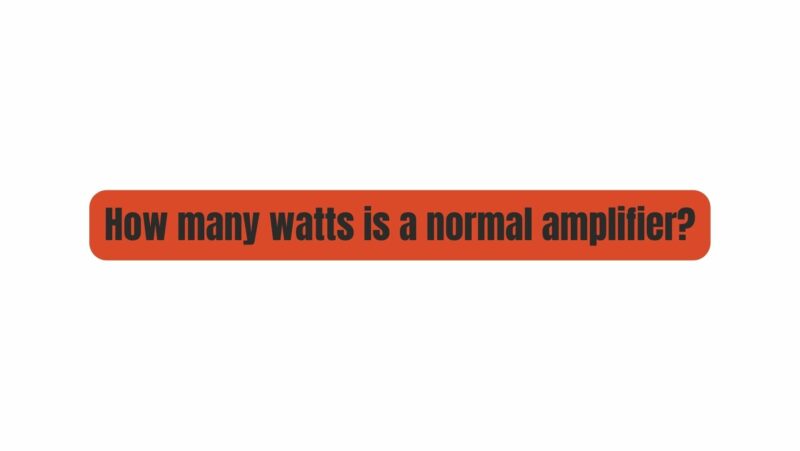Amplifiers are essential components of audio systems, serving the purpose of amplifying signals from musical instruments, microphones, or electronic sources. Amplifier wattage, measured in watts (W), is a critical specification that indicates the power an amplifier can deliver to drive speakers and produce sound. The typical wattage of an amplifier can vary significantly depending on its intended use, application, and the type of audio equipment it complements.
1. Guitar Amplifiers
Guitar amplifiers come in a wide range of wattage options to cater to different playing situations and musical styles. The typical wattage for guitar amplifiers can be categorized as follows:
- Practice Amps (5-20 Watts): Practice amps are designed for personal practice and small jam sessions. They offer enough volume for quiet practice and may include headphone jacks for silent playing.
- Gigging Amps (20-50 Watts): Gigging amplifiers provide ample volume for live performances in small to medium-sized venues. They are versatile and suitable for various musical genres and playing styles.
- Stage and Touring Amps (50+ Watts): Professional musicians performing on larger stages and in concert settings often use high-wattage amplifiers to ensure their sound reaches the entire audience.
2. Bass Amplifiers
Bass amplifiers are specialized for amplifying the low-frequency sounds produced by bass guitars and other low-frequency instruments. The typical wattage for bass amplifiers can be categorized as follows:
- Practice Amps (15-50 Watts): Similar to guitar practice amps, these lower-wattage bass amps are designed for individual practice and small rehearsal spaces.
- Performance Amps (50-300 Watts): Bass amplifiers in this range are suitable for live performances and offer the necessary low-end punch for various musical genres.
- Professional and Touring Amps (300+ Watts): Professional bassists and those performing in larger venues may opt for high-wattage amplifiers to ensure the projection of bass frequencies.
3. Keyboard Amplifiers
Keyboard amplifiers are designed to amplify electronic keyboards and synthesizers. The typical wattage for keyboard amplifiers can vary:
- Practice and Small Venue Amps (20-100 Watts): These amplifiers are suitable for home practice and small gigs in intimate settings.
- Stage and Performance Amps (100-300 Watts): Keyboardists performing in larger venues or with bands may require amplifiers in this range to achieve the necessary volume and sound projection.
4. Acoustic Amplifiers
Acoustic amplifiers are tailored to reproduce the natural sound of acoustic instruments like acoustic guitars and violins. The typical wattage for acoustic amplifiers can range from 20 watts for small practice amps to 200 watts or more for professional performance amps.
5. PA (Public Address) Amplifiers
PA amplifiers are used in sound reinforcement systems to amplify audio for large audiences in venues such as theaters, concert halls, and outdoor events. PA amplifier wattage can vary widely, from a few hundred watts for small venues to several thousand watts for stadiums and arenas.
6. Hi-Fi (High-Fidelity) Amplifiers
Hi-Fi amplifiers are intended for home audio systems and provide high-quality sound reproduction. The wattage of hi-fi amplifiers can vary, with some models offering 20-50 watts per channel for stereo setups and more powerful amplifiers for larger home theater systems.
7. Average Wattage and Application
The choice of amplifier wattage should align with the specific application and intended use:
- Personal Practice: For personal practice in a bedroom or small space, practice amps with 5-20 watts are typically sufficient for guitar, bass, or keyboard.
- Rehearsals and Small Venues: Amplifiers with 20-50 watts are suitable for band rehearsals and performances in small to medium-sized venues.
- Live Performances: Larger venues and outdoor concerts may require amplifiers with 50 watts or more to achieve the necessary volume and projection.
- Recording Studios: In recording studios, lower-wattage amplifiers are often preferred for achieving specific tones at lower volumes.
8. Speaker Efficiency and Wattage
The efficiency of the speakers used in conjunction with an amplifier plays a crucial role in determining the perceived volume. More efficient speakers can produce higher sound levels with less amplifier power, whereas less efficient speakers require more power to achieve the same volume. Therefore, the efficiency of the speakers should be considered when selecting an amplifier.
9. The 3 dB Rule
Understanding the 3 dB rule is important. It states that to double the perceived loudness of a sound, you need to increase the power by a factor of ten. Conversely, to halve the perceived loudness, you need to reduce the power by a factor of ten. This rule highlights the non-linear relationship between power and perceived volume.
10. Amplifier Design and Quality
Amplifier design, including circuitry, amplifier class (Class A, Class AB, Class D), and component quality, can influence how efficiently an amplifier converts electrical power into sound. Well-designed amplifiers can achieve higher perceived volume levels with less power.
Conclusion
The typical wattage of an amplifier varies widely based on the type of amplifier and its intended use. Understanding the typical wattage ranges for different types of amplifiers is crucial for selecting the right amplifier to meet specific audio needs. It’s essential to consider factors such as speaker efficiency, venue size, and application when choosing an amplifier to ensure that the desired volume and sound quality are achieved.
Ultimately, the appropriate wattage for an amplifier depends on a balance between power and practicality, as well as the desired sonic outcome. Whether you’re a musician, audio enthusiast, or professional audio engineer, having a clear understanding of amplifier wattage and its relevance to your specific needs will help you make informed decisions when it comes to selecting and using audio equipment.


